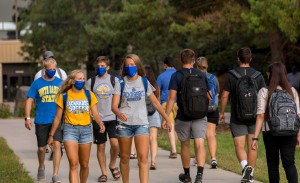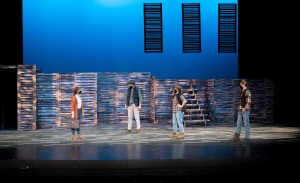A COVID axiom: Adversity makes us stronger
Weird as it was to see more fans at a high school football game than at an NFL stadium, it was equally as odd to not have football on the South Dakota State University campus in fall 2020.
For the first time since 1943, the gridiron at State was silent. (Even the 1944 team went 1-1.)
By mid-February, with temperatures double-digits below zero, fall sports—football, soccer, volleyball and even a cross country meet—were underway or soon to begin. Traditional spring sports like baseball and softball were underway as well as the usual array of winter sports.
The COVID-19 pandemic that turned the world upside down still stretches normalcy beyond recognition, but glimpses of a more-normal campus are in sight. The number of in-person classes have increased in spring semester. During fall semester, SDSU offered 820 in-person classes, 781 online classes and more than 700 were hybrid—some sessions in person, some online. In spring semester, 50% of classes were held face-to-face, 43% hybrid and 7% online only.
Students can again be seen trekking from building to building between classes and more events are being planned on campus, though with COVID-19 restrictions.
Protocols keep campus safe
COVID-19 protocols put in place during the summer allowed the university to conduct a full fall semester. Like all universities in the South Dakota Board of Regents system, the first day of class was moved up, Monday holidays were eliminated and finals were conducted online with students not returning to campus after dismissing Nov. 22 for Thanksgiving.
President Barry Dunn and the university’s COVID-19 Response Team—led by Public Health Specialist Laura Dirks ’17, Daniel Scholl, an epidemiologist, and vice president and general counsel Tracy Greene—consulted with Sanford Health and government officials to set testing and tracing protocols.
 By order of the Regents, a mask mandate was in place for campus buildings from the start of the semester and the Brookings City Council adopted a mask mandate Sept. 2.
By order of the Regents, a mask mandate was in place for campus buildings from the start of the semester and the Brookings City Council adopted a mask mandate Sept. 2.
Vice President of Student Affairs and Enrollment Management Michaela Willis said, “Students, faculty and staff did an amazing job of wearing face coverings, social distancing and following protocol. I’m amazed how few student conduct violations we had for face coverings and other protocols,†Willis said. “It showed they cared about each other, and they wanted that student experience. I’m grateful to them for making those small changes.â€
Among COVID-19 protocols was a residence hall guest policy that didn’t allow nonSDSU students. It also limited occupancy only to the residents and an equal number of guests, so four for a double occupancy room.
The university also cut occupancy in residence halls. A ratio of six residents to one bathroom was implemented. In addition, Waneta Hall was re-opened after being taken out of residence hall options in 2019-20.
Student testing critical aspect
Willis added that the university quickly took leadership by setting up student COVID-19 testing in late August.
“This had a huge impact on our success,†Willis said. “We created a drive-thru/walk-thru student testing site for COVID-19 through the Student Health Clinic and ADRDL’s (Animal Disease Research and Diagnostic Laboratory) newly established One Health Lab (a new offering specifically developed as a result of COVID-19 test processing needs at SDSU), resulting in 24-hour PCR test results.
“Our students received free testing on demand and results were received more quickly than they could receive results from any other health care provider in our area. In some cases, test results were communicated on the same day. This played an important part in reducing the spread of COVID-19 at SDSU.
“We are the only higher education institution in the state with this type of rapid PCR (polymerise chain reaction) testing for students.â€
The drive-thru testing center ran five hours a day Monday through Friday and four hours daily on the weekends.
Jack fans: Blue and true
Athletic Director Justin Sell said when fall sports disappeared, “we didn’t get refund calls.†Instead, people called to say, “‘I can’t imagine what you are going through. What can I do to help?’ ‘We believe in you. We’ve been here for 30 years, and we’ll be here the next 30 years.’ It makes us proud to be a part of this place,†Sell said on behalf of his department.
He said it was encouraging to listen to the callers, “to know they are on our side. There were points in the summer we didn’t even know what we needed help with.â€
Evidence of Jackrabbit loyalty was also seen at the May 2 scholarship auction, which was moved to a virtual format and resulted in a record $1,737,600.
That total, which was bolstered by a two-to-one match from an anonymous donor, included a record $1.15 million for athletic scholarships, $372,000 for Feeding South Dakota and $207,000 for high-need scholarships at SDSU.
The amount raised for Feeding South Dakota is enough to provide 1.1 million meals.
“We had high expectations going into this year’s auction, but the response from Jackrabbit Nation is nothing short of extraordinary,†Sell said. “To set a record for athletic scholarships and raise another half-million dollars for other important causes in our campus community and state speaks to how special our university is to so many people.Â
“The auction set the tone for our ability to come together and positively handle the biggest challenges of our lifetime.â€
As for COVID-19 itself, the department fared very well, he said. “Student-athlete testing began the second week of August. On a daily basis, we have tremendous protocols that help us keep our student-athletes and staff as safe as possible and reduce the risk of spreading the virus.†He added offices were vacant until Aug. 1 and squads didn’t use team or locker rooms during the offseason throughout the fall.Â
Performing arts: The show went on
In the School of Performing Arts, director Dave Reynolds said, “More events were held than canceled. Most junior and senior recitals as well as faculty recitals were given with very few in-person audience members in Founders Recital Hall.â€Â
Capacity there was capped at 22 individuals (225 seats available) while in Larson Memorial Concert Hall and Oscar Larson Theatre (1,000/850 seats available) capacity was limited to 90 to 100 for band, choir and orchestra concerts as well as a theater production.
 Thanks to a gift from the Dian Graves Owen Foundation, spouse of SDSU alum Harlan Stai ’69, SDSU was able to buy new video recording equipment so productions could be aired via Facebook Live. That opened performances grand and simple to an entirely new audience, Reynolds said.
Thanks to a gift from the Dian Graves Owen Foundation, spouse of SDSU alum Harlan Stai ’69, SDSU was able to buy new video recording equipment so productions could be aired via Facebook Live. That opened performances grand and simple to an entirely new audience, Reynolds said.
“I’m very surprised to see who was watching—grandma and grandpa in St. Louis, an aunt and uncle in Arizona. Well-wishers from a long ways away could still enjoy the performances,†Reynolds said.
He foresees that option continuing after the pandemic ends.
‘A spirit that will just make us stronger’
Senior Reis Bruley, the Students’ Association vice president, said what he experienced at SDSU in the past year has left him optimistic for the future.
“Operating in pandemic times has really helped us in the long run,†he said. “To be able to operate successfully during those conditions will only leave us better prepared for when the pandemic disappears.â€
He expects hybrid learning to survive long after the virus is wiped out.
“Now that every room is connected with technology, we could have students all over the country, all over the world, participating in a class from their home. It could open up higher education to a broader group of people. It will be interesting to see how things change in the next five years.Â
“We want our room occupancies to go up and we don’t always want our professors sitting behind a shield, but I see hybrid learning continuing.
“SDSU administration put an emphasis on student safety, student experience and academic rigor. That also is what is going to help us in the future. We have really, really good students that respected what was put in place and they really wanted to be in Brookings; that didn’t happen all over the United States,†Bruley said.
Willis added, “We saw a lot of the best from people, especially faculty and staff willing to do what it took to serve students, and I think that’s a spirit that will just make us stronger.â€
-Dave Graves






